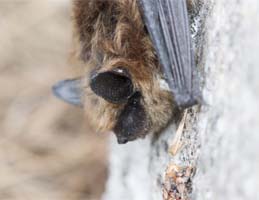(703) 881-3170
Virginia Bat Information
Eastern Small-footed Bat

The Eastern Small-footed Bat is currently listed as endangered in the state of Virginia by the Virginias Department of Wildlife Resources. This bat is suffering from the same issues as the Indiana Bat. Most notably it's susceptibility to white-nose syndrome. They are also dying out from pollution (notably water pollution) and human disturbance during hibernation. Eastern Small-footed Bats have few fat reserves when they hibernate. And when they are disturbed during hibernation they use a lot to flee, which can lead them to starve and die in the winter. They tend to hibernate in shallow caves during the winter and roost on ground-level rocky outcroppings in the summer and spring. Since the Eastern Small-footed Bat is endangered killing these bats is illegal, and consideration must be taken if you want to remove these animals from your home.
Eastern Small-footed Bat Characteristics
The Eastern Small-footed Bat got its name from its abnormally small feet for a bat of its size at 0.7-0.8 centimeters (for comparison normal bat's foot length is 1-1.5 cm) They can reach sizes between 2-4 inches long with a wingspan of 8-10 inches long. The Eastern Small-footed bat is a light brown with a black face mask, their ears, and wings are also a dark color.
Eastern Small-footed Bat Mating and Breeding
Little known is about the reproduction habits of the Eastern Small-footed bat. However mating season is assumed to start in the summer, but they can mate during hibernation if awake. Like other species of the Myotis Genus (Mouse Eared Bats) these bats have delayed fertilization. This means that the female will delay fertilization after mating so that they can give birth after hibernation. These bats usually only have one offspring per birth but twins can sometimes happen. Due to this, these bats are highly susceptible to mortality rates, and numbers will decrease dramatically if a few of their numbers die.
Eastern Small-footed Bat Diet
The Eastern Small-footed Bats primarily eat insects most notably, beetles, moths, and flies. But they mostly eat moths, as they tend to avoid hard-shelled prey. These bats typically hunt during the night around streams cliffs and near the canopy height of the trees.
